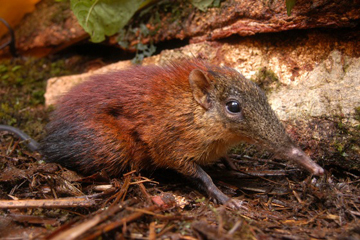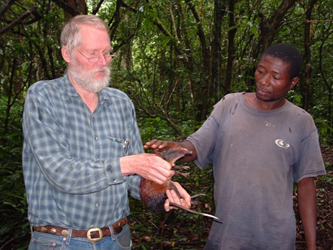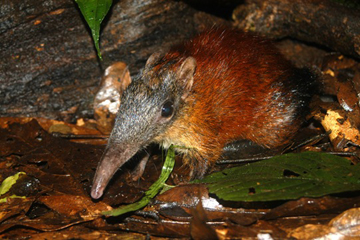Researchers have discovered the world’s largest shrew in a remote part of Tanzania where a trove on previously unknown species have been recorded in the past few years. The species is more than a quarter larger than any previously known shrew.
More than a quarter larger than all of its relations, the Grey-faced sengi (Rhynchocyon udzungwensis) was first discovered on a roll of film from camera traps set-up in the Udzungwa Mountains of Tanzania. The photos of this mysterious giant elephant-shrew were sent to expert Dr. Galen Rathbun, who has studied the sengi (or elephant-shrew) for over thirty years; after examining the photos he believed that the animal’s unique coloring proved it was an unknown species.
Rathbun led an expedition to locate the elephant-shrew in March 2006, which included the original camera trap photographer, Francesco Rovero of the Trento Museum of Natural Sciences in Italy. Four individuals of the new species were found and studied.

|
“This is one of the most exciting discoveries of my career,” said Rathbun, “It is the first new species of giant elephant-shrew to be discovered in more than 126 years. From the moment I first lifted one of the animals into our photography tent, I knew it must be a new species not just because of its distinct coloring, but because it was so heavy!” The Grey-faced sengi weighs in at 1.5 lbs. It is named for its gray face, which gives way to a reddish-orange back and a black bottom.
Sengis are truly unique mammals. Just sixteen species (including the Grey-faced sengi) comprise their particular order of Macroscelidea. All sixteen are native to Africa and mate monogamously. Sengis (which is their Bantu name) were called elephant-shrews by Europeans who thought the animals were shrews with flexible trunks, not unlike an elephant’s. In a biological twist, recent molecular research has uncovered that the Macroscelidea are actually more closely related to elephants than shrews. Their closest relatives are a true mismatch of mammals, including aardvarks, hyraxes, and manatees—along with elephants. All of these unique species trace their lineage back to the super order, Afrotheria, which split off from other mammals 100 million years ago.
 Dr. Galen Rathbun and Ruben Mwakisoma of the Tanzania Forest Conservation Group. Photo by David Ribble. |
Only two populations are so far known of the Grey-faced sengi, covering 115 square miles in the forests of the Udzungwa Mountains. It is believed that the species is rare. When asked about conservation regarding sengis, Dr. Rathbon says that the sengis “that are at risk are the four species of Rhynchocyon [including the Grey-faced sengi] that are found in forests. Although they are hunted in some areas, the real problem is the reduction and fragmentation of their forest habitats due to urban and agricultural development and extraction of timber. If their habits can be secured, in most forests they will do alright.” The most endangered, so far, is the Golden-rumped elephant-shrew, which before this new discovery was the largest sengi. The Golden-rumped elephant-shrew is currently a focal species for EDGE’s (Evolutionary Distinct and Globally Endangered) conservation efforts.
 Dr. Galen Rathbun with the Grey-faced sengi. Photo by David Ribble. |
Such efforts are also need in Tanzania’s Udzungwa Mountain region. The unique mountain and forest habitat have yielded a number of incredible new species recently. In 2003 a new species of monkey was discovered, named the Kipunji, in the same forest as the Grey-faced sengi. A new partridge, name Udzungwa partridge, and a new shrew species, Phillip’s Congo shrew, have also been discovered in the region. Additionally, the mountains serve as a refuge for species during the dry season, yet it has been estimated that the forests linking the mountains to adjacent areas may be lost by 2009 if nothing is done. “We hope that new discoveries like ours will help bolster efforts to conserve this spectacular ecosystem,” says Rathbun.
This may not be the last new sengi: “A group of biologists at Stellenbosch University in South Africa have probably found a new species of Elephantulus,” Rathbun revealed (Elephantulus is another genus of the sengi), “but it is quite cryptic—requiring sophisticated molecular methods to distinguish it from other species in this genus. It has not yet been published, so it is not yet recognized.” He added, “It would be surprising to find a new species as dramatically different as the Grey-faced sengi is from the other species.”














